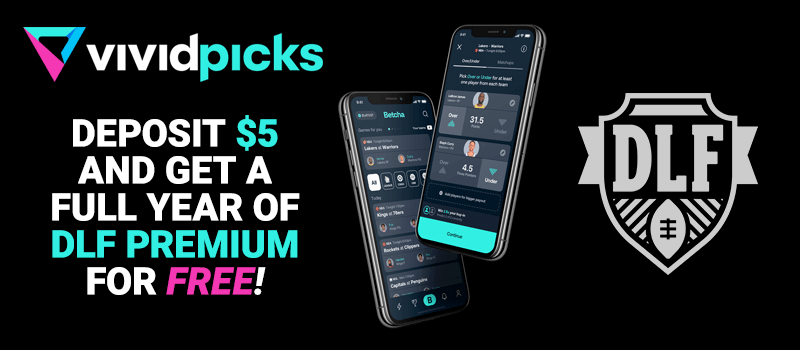GET DLF PREMIUM FOR FREE
You can get a full year of DLF Premium Membership, for FREE! Through one of our ongoing partnership promotions you can set yourself up with access to the best dynasty fantasy football resource on the planet, simply by joining and depositing with one of our partners. See the offers and details below.
Get a free DLF Premium Membership by depositing $5 or more through Vivid Picks!
In addition, your first deposit amount is matched up to $200!
Be sure to use the code “DLFyearly” when registering.
* You may sign up for Vivid Picks and deposit funds while in any state, but funds can only be played while physically located in eligible states.
You can find all of the details about the Vivid Picks offer here.
TO RECEIVE A FREE YEAR OF DLF PREMIUM THROUGH VIVID PICKS
- Download and install the Vivid Picks App on your mobile device
- Create a NEW Vivid Picks Account
- You must enter Invite code: DLFYearly
- Deposit $5 or more
- Your initial deposit will be matched up to $200!
- Once you have made the deposit, allow 24-36 hours four your DLF Membership to be activated.
- IMPORTANT: Vivid Picks requires you to be a new user & make a minimum deposit of $5. You must enter the promo code "DLFYearly" when creating your account or it will not work.
STATES WHERE VIVIDPICKS IS ELIGIBLE
* You may sign up and deposit funds while in any state, but funds can only be played while physically located in eligible states.
WHY SUBSCRIBE TO DLF?
- DLF is the most trusted resource for dynasty fantasy football
- Year Round Content and Analysis
- The best, most current Dynasty Rankings anywhere
- Over 20 amazing tools including the Trade Analyzer and Mock Draft Tool
- Podcasts, videos, personalized advice and so much more!
Check out all of the amazing tools and features we offer. There is no other dynasty fantasy football resource anywhere that offers so much for so little. You never stop building your dynasty and we never rest in giving you all of the tools you need to crush the competition.
At DLF, there truly is No Off-Season!
THIS OFFER NOT A GOOD FIT FOR YOU?
If this offer does not work for you for whatever reason, you can always subscribe through one of our regular membership plans. Just hit the button below to see all the ways you can join the best dynasty fantasy football community on the planet!


